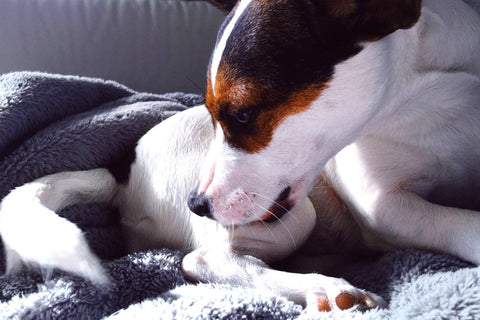
Hot spots on dogs can be a cause of concern for pet owners. These inflamed and irritated areas of the skin can be painful for dogs and can lead to incessant itching and scratching. In this article, we will delve into the causes of hot spots on dogs and explore the best treatment options available.
Hot spots, also known as acute moist dermatitis, can occur due to a variety of factors. Common causes include allergies, insect bites, bacterial or fungal infections, and poor grooming habits. Understanding the underlying cause of the hot spot is essential in providing effective treatment.
When it comes to treating hot spots, there are several options available. Depending on the severity of the condition, treatment can range from topical ointments and medicated shampoos to oral medications and holistic remedies. It's important to consult with a veterinarian to determine the best course of action for your dog's specific situation.
By gaining a better understanding of the causes of hot spots and finding the most suitable treatment, you can help your furry friend find relief from discomfort and prevent the recurrence of these irritating skin conditions.
What are hot spots on dogs?
Hot spots, also known as acute moist dermatitis, are localised areas of inflamed and irritated skin that can occur in dogs. These spots are usually red, moist, and extremely itchy, causing discomfort and distress for our furry friends. Hot spots can vary in size, ranging from small patches to larger areas on the dog's body. They commonly occur on the head, neck, hips, and limbs.
Common causes of hot spots
Understanding the underlying causes of hot spots is crucial in effectively treating and preventing their occurrence. There are several factors that can contribute to the development of hot spots on dogs.
One common cause is allergies. Dogs can be allergic to a variety of allergens, including food, environmental factors such as pollen or dust mites, and certain materials like fabrics or cleaning products. When a dog comes into contact with an allergen, it can trigger an allergic reaction that leads to hot spots.
Insect bites can also be a cause of hot spots. Fleas, ticks, mosquitoes, and other biting insects can irritate a dog's skin and cause intense itching. When a dog scratches or bites at the affected area, it can create a hot spot.
Bacterial or fungal infections can also contribute to the development of hot spots. These infections can occur when bacteria or fungi enter a dog's skin through a wound or a pre-existing skin condition. The warm and moist environment of a hot spot provides an ideal breeding ground for these microorganisms.
Poor grooming habits can also lead to hot spots. Dogs with long or thick fur are more prone to hot spots, as their dense coats can trap moisture and create a humid environment. Additionally, dogs that are not regularly groomed may have dirt, debris, and mats in their fur, which can irritate the skin and contribute to the development of hot spots.
Signs and symptoms of hot spots
Identifying the signs and symptoms of hot spots is crucial in providing timely treatment and relief for our furry companions. Common signs of hot spots include:
1. Redness and inflammation: Hot spots are usually red and swollen, indicating inflammation in the affected area.
2. Moist and oozing skin: Hot spots are often characterised by moist and oozing skin due to the dog's constant scratching and licking.
3. Itching and scratching: Dogs with hot spots will exhibit excessive itching and scratching behaviour, often leading to further irritation and worsening of the condition.
4. Hair loss: As a result of constant scratching and licking, hair loss may occur in and around the hot spot area.
5. Foul odour: Hot spots can emit a foul smell due to the presence of bacteria or fungi.
Diagnosing hot spots
If you suspect your dog has a hot spot, it's essential to seek veterinary care for a proper diagnosis. A veterinarian will examine the affected area and may perform additional tests to rule out underlying conditions or infections. The vet will also determine the severity of the hot spot and recommend the most appropriate treatment plan.
Preventing hot spots in dogs
Prevention is key when it comes to hot spots in dogs. By taking proactive measures, you can reduce the risk of your furry friend developing these uncomfortable skin conditions.
Regular grooming is essential in preventing hot spots. Brushing your dog's fur helps to remove dirt, debris, and mats that can irritate the skin. It also helps to distribute natural oils, keeping the skin and fur healthy.
Keeping your dog's skin clean and dry is also important. After bathing or swimming, make sure to thoroughly dry your dog's coat to prevent moisture from getting trapped and creating a humid environment.
Maintaining a healthy diet and addressing any food allergies or sensitivities can also contribute to preventing hot spots. Consult with your veterinarian to ensure your dog is receiving proper nutrition and to identify any potential dietary triggers.
When to seek veterinary care for hot spots
While mild cases of hot spots can often be treated at home, it's important to know when to seek veterinary care. If your dog's hot spot is severe, does not improve after a few days of home treatment, or if your dog is exhibiting signs of pain or discomfort, it's best to consult with a veterinarian.
A veterinarian will be able to assess the hot spot, determine the underlying cause, and provide the most effective treatment plan. They may prescribe topical ointments or medicated shampoos, oral medications such as antibiotics or antihistamines, or recommend holistic remedies to alleviate the symptoms and promote healing.
Topical treatments for hot spots
When it comes to treating hot spots, there are several topical treatments that can provide relief and aid in the healing process. These include:
1. Topical ointments or sprays: These products can help soothe the affected area, reduce inflammation, and promote healing. Look for products that contain ingredients like hydrocortisone or aloe vera.
2. Medicated shampoos: Using a medicated shampoo can help cleanse the affected area, alleviate itching, and prevent further infection. Look for shampoos that contain ingredients like chlorhexidine or benzoyl peroxide.
It's important to follow your veterinarian's instructions when using topical treatments and to monitor your dog's progress closely. If the hot spot does not improve or worsens despite treatment, consult with your veterinarian for further guidance.
At Delivery Hound HQ, we know first hand that hot spots can be a cause of discomfort and distress for our beloved dogs. Understanding the causes of hot spots and finding the most suitable treatment options is crucial in providing relief and preventing their recurrence. By practicing good grooming habits, addressing allergies or sensitivities, and seeking veterinary care when necessary, we can help our furry friends lead happier and healthier lives, free from the discomfort of hot spots.
©deliveryhound.com.au 2023






